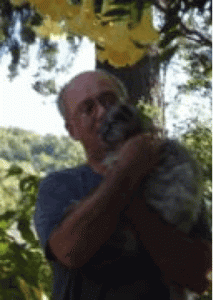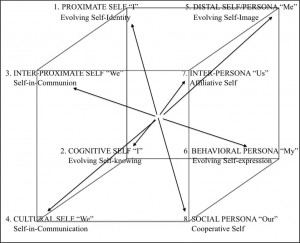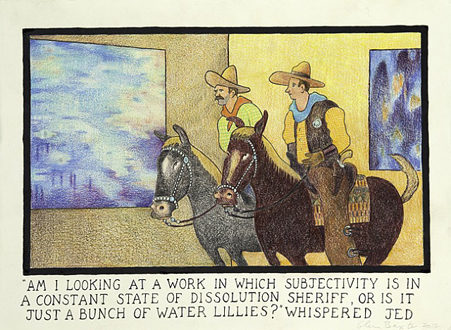Where the title reads "controversial spiritual teacher," please read
abusive guru, the designation he has had on this blog for as long as I have been following the integral community and its assortment of associated male perpetrators.
Andrew Cohen has been one of the most overt abusers through his use of authoritarian control over followers, much of which is documented on the blog
What Enlightenment??! and
EnlightenNixt, the compendium/companion site where many of the older posts are archived.
See also William Yenner's
American Guru: A Story of Love, Betrayal and Healing-former students of Andrew Cohen speak out and Luna Tarlo's
The Mother of God (Tarlo is Cohen's mother, a former follower, and a cogent observer of Cohen's controlling and manipulative tactics).
There has been growing issues around Cohen and his
EnlightenNext organization over the past several years.
A few years ago (2010), they put up for sale their Fox Hollow compound in the Berkshires (MA). Although they maintained that the sale was in response to a more international presence of the organization, there were rumors floating around the Web that they had fewer devoted students, which meant less money coming in.
In 2011,
EnlightenNext (the magazine formerly known as
What Is Enlightenment?) ended its publication run of over 19 years and 47 issues, due to the "widespread financial challenges of the print industry."
Both of these events seem more serious in retrospect than they did at the time. According to information posted yesterday at
What Enlightenment??!,
Sources close to EnlightenNext have since told us that criticism of Cohen began in the upper echelons over four years ago. Sometime over a year ago, some of these senior students were ordered by Cohen to meet together in London, apparently to attempt to purge themselves of their rebelliousness. Instead, at their meetings their questioning of Cohen’s authoritarian style of leadership deepened. They eventually stopped sending Cohen notes of their meetings, as expected and required. Soon they were joined in their dissent by other EnlightenNext leadership. A united front formed. As if this were not shocking enough, we heard that things had recently come to a head in a meeting between senior students and Cohen in Europe. A line was drawn in the sand, it was said. Not being satisfied with Cohen's response, a number of leaders left the community. Many other members followed suit.
And of course, Cohen's PR team is trying to spin the defections - and the fact that Cohen is steping away from his role as Guru and as leader of EnlightenNext - as simply the next progression of the organization's evolution.
EnlightenNext appears to be attempting to explain the changes as part of a natural evolution away from the authoritarian-mythic “blue meme” guru model, using terminology originated by Don Beck and Chris Cowan in their Spiral Dynamics model of human development, a model which has been widely adopted by Integral Theory teachers and thinkers, such as Ken Wilber. The PR Plan also identifies the need to address “Founder’s Syndrome,” a situation where the founder of an organization impedes its development. These theoretical explanations, with no mention of the harm Cohen and his organization have done to students and with no inkling of empathy for the suffering those students endured, make one wonder whether EnlightenNext’s culture of authoritarianism and abuse will really change.
And what to make of the silence of those in the leadership who reportedly parted from Cohen? Although supposedly disaffected with Cohen, Jeff Careirra taught an on-line EnlightenNext program as recently as last weekend. Carter Phipps, who has been living in the Bay Area of California for almost a year, promoting his book “Evolutionaries” and participating in Integral community-related activities, has not publicly disclosed his split from Cohen or his future plans. Other students and EnlightenNext leaders have publicly remained similarly silent.
If you doubt the people around Cohen are well-trained in manipulated their public message, the good folks at What Enlightenment??! posted the PR plan being implemented around the coup d'etat led by Cohen's senior students.
It makes for interesting reading:
From: Rosalind Bennett <rosb@enlightennext.org>
Date: June 15, 2013, 7:09:43 PM EDT
To: Rosalind Bennett <rosb@enlightennext.org>
Subject: PR & Communications plan for Andrew
Hello there,
I just sent out the email below to the current Core students (Defining, Resolute and Committed Core) and also wanted you all to hear about our PR communications plan for Andrew. I'm sending this to everyone who I know is involved in the current programs and who I've personally spoken to, please feel free to forward this email on to others involved who would like to hear the messaging going forward.
Thanks so much,
Love,
Ros
---------------------------------------------------------------------------------------------------------
Dear All,
I wanted to let you know the PR communications plan for Andrew that will roll out in the next few weeks.
As most of you know Joel Pitney and I are responsible for Andrew's PR and media platform and we have been working on a message to the broader public regarding the situation we are in the midst of with Andrew, and all the subsequent changes.
Many of you have contacted us sharing your urgency around making a public statement, and we thank you all for your input! We have taken everything you have said into consideration and come up with a plan that we are very happy with.
Before I go any further I want to point out that while we're working very closely with Mary, Aterah, Morgan and the Education Department in our communications, what Joel and I are specifically responsible for (and what we've outlined in this email) has to do with communications from the Andrew Stream (to the broader public, Andrew's personal relationships, etc), and not the communications for the education programs and long retreats.
GENERAL STRATEGY:
We felt it was imperative to get an "outside perspective" on our PR communications as, being close students of Andrew in this emotionally charged situation, it's very difficult to envision the right message for the public at large. Our primary consultant has been our PR advisor Nate Winstanley. Nate is not only an excellent PR consultant, but he also trained in crisis management. He has been working with us for the last several years, and is fully appraised of Andrew's history, the history of EnlightenNext, and the current situation. Given his experience and his friendship with Andrew, we feel that he is the perfect person to help us with this messaging now, and his input has been invaluable.
Nate has helped us to see that the most important point to consider in relationship to our PR strategy is that there is a tremendous difference between communicating to our "internal" audience of past and present students, and our "external" audience of people who follow Andrew's work, but are not part of any formal structures or communities (see a breakdown/description of our audiences at the end of this email). Nate also stressed how important it is that our public messaging be appropriate to our external audience, and that this should not be expected to address the issues that pertain to our "internal" audience of past and present students.
He made it very clear that from an outside perspective, what is currently happening represents an evolution of both our organization/movement and Andrew's work. The fact that Andrew is acknowledging his mistakes, has stepped down from his role as Guru, and will be stepping down as head of the organization, is a reflection of the fact that our movement is changing and growing, and that Andrew is taking the necessary time off to reflect, respond, and take the next step in his own development.
For the internal group of past and present students, Andrew must find a different and appropriate way to make peace; and, as most of you know, this internal process has already begun. He has already stepped down from his Guru role, which is on hiatus until spring 2014, and he is in the midst of responding appropriately to many past and present students.
STEPPING DOWN FROM LEADERSHIP:
Another very important distinction in our messaging that Nate helped us to understand has to do with how to announce Andrew's "sabbatical." He clarified that to frame the time that Andrew will be taking to reflect and respond as a sabbatical is not accurate. Given that Andrew will be doing a minimum of teaching work during this period, (the retreats and French forum) and that our many programs and content streams will continue in some form, from an outside perspective calling this time period a "sabbatical" would be confusing. Instead he suggested we emphasize in our public messaging that Andrew is stepping down from leadership, both within the organization and the spiritual community, and will be taking time to reflect and respond.
So in our public statements, which will launch on Andrew's blog on June 28th (see Blog Themes below for more detail), we will announce that Andrew is "stepping down from leadership" rather than "taking a sabbatical." We feel that this is also more authentic as to what is actually happening, so please consider this in your own communications.
BLOG THEMES:
Our public messaging will center around a series of blog posts which will be published on all of the sites where Andrew writes (BigThink, HuffPo, etc) in addition to AC.org. They will be on two themes outlined below. The first blog will also be accompanied by an email to our list announcing Andrew's decision to step down from leadership and offer some description of how the EnlightenNext programs will be continuing forward:
Confronting Founder's Syndrome: In this initial post, Andrew lays out what is happening for him right now in the context of "Founder's Syndrome," which is a common phase that organizations go through when due to a lack of willingness to give up control its visionary Founder gets in the way of the further evolution of the organization. He'll announce in this post that to address this situation, he's stepping down from leadership of both the organization and the spiritual community, and will radically reduce his teaching engagements to take time to reflect and respond.
The Death of A Mythic Guru: In this second post (which may end up in multiple parts), Andrew will speak about his own development as a Guru and how he created a "mythic" Guru model within the postmodern world, outlining the negative and positive consequences of that. He'll talk about how difficult it has been for him to recognize the mythic structures within himself, and how he's going to now take the time necessary to develop both himself and the teachings.
COMMUNICATIONS CALENDAR:
Below is a list of the various communications that will go out to our different audiences over the next month:
- Today: Overview of communications strategy/plan to the Defining, Resolute, Committed, and Past students (this email!)
-
Next few weeks: Series of calls/emails to various donors.
- 6/28: Blog #1 on Founder's Syndrome will go up on BigThink
- 6/28: Accompanying the blog will be an email to our email list announcing that Andrew is stepping down from leadership and giving a brief overview of what kinds of offerings they will continue to get from both Andrew and EnlightenNext.
- 7/6: Guru & Pandit Virtual Broadcast on the theme of The Death of A Mythic Guru
- 7/12: Blog #2 on The Death of A Mythic Guru goes up on BigThink
Thank you all for taking the time to read this. I apologize for the length of this email, but we felt it was important that we keep everyone informed as much as we can during this challenging period of our lives.
Also, when we have an approved plan of how Andrew's business line will be going forward, I'll send out another email.
Best wishes all,
Ros & Joel
AUDIENCE BREAKDOWN:
Below is a description of the various audiences that we're reaching out to and an overview of the basic messaging strategy for each:
"INTERNAL AUDIENCES":
Past and Present Students:
Includes all Defining, Resolute, and Committed Core students and people who have been close students in the past. We are the people who are the most affected by what is happening and have the most investment in the whole situation and subsequent changes. These communications have several dimensions: First and foremost, Andrew is following up personally with people, both current and past students. Second, we as his communications team want to keep everyone abreast of our overall communications, so that everyone knows why we're saying what we're saying.
Donors:
This audience has a significant overlap with past and present students. Since they have all committed financial support to Andrew and EnlightenNext, it is important for us to communicate how the current situation will affect Andrew's and the organization's short and long-term future, and the financial implications of this. We will be reaching out to communicate directly with our current donors within the next few weeks.
"EXTERNAL AUDIENCES":
Blog Readers:
This is our broadest audience and consists of people who engage with Andrew's content on a wide variety of external platforms (BigThink, Speaking Tree, HuffPost, etc). This audience is least familiar with Andrew and sees him more as a spiritual thought leader and less as a Guru with a community of students. This audience is the least interested in hearing about the details of our current situation, and our plan to communicate with them is through a series of blogs in which Andrew will speak about the current situation in more of a philosophical/cultural context (outlined in the Blog Themes section).
Email List:
This is a group of about 35K people (~12K of which are very active) who receive consistent communications from us about new content, events, and products. This audience is a mix of people, but generally has more familiarity with Andrew's role as a teacher and also leader of our organization. Our primary communications to them will draw upon themes in Andrew's blog, but speak specifically about how we as an organization plan to respond to this situation and how that will affect the content and programs that they are used to hearing about.
Integral/Evolutionary Community:
This is the segment of our public audience that is most familiar with the deeper dimensions of Andrew's work as a Guru and spiritual innovator. This audience has been following Andrew's work through the magazine, through the Guru & Pandit dialogues, and through other platforms like Craig Hamilton's, and is more familiar with the spiritual and philosophical stands that Andrew has taken in the post-traditional spiritual world. Our plan for this audience is for Andrew to use some of the remaining Guru & Pandit Virtual dialogues with Ken this year to explore some of the "Mythic-to-Post-Mythic-Guru" themes that are at the heart of the current situation.
Rosalind Bennett
















